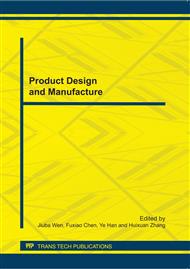p.134
p.138
p.144
p.148
p.154
p.159
p.164
p.168
p.172
Integration System of Intelligent Design and Modeling Oriented to Requirement Configuration for Palletizing Robot
Abstract:
The method of computer-aided conceptual design is present for the palletizing robot. Intelligent design and modeling are integrated in this system. Index of design requirement is quantified hierarchically and various kinds of attributes of function carriers are digitized. The analytic hierarchy process is used for reference to check the consistency of quantitative value of attributes and the rationality is ensured. Design requirement can be configured flexibly in man-computer interaction module and the optimal scheme is generated automatically according as the computation of evaluation function. Model file of virtual prototype for ADAMS can also be generated automatically by auto-modeling module. Software system of computer-aided conceptual design for palletizing robot is developed based the method mentioned above.
Info:
Periodical:
Pages:
154-158
Citation:
Online since:
October 2011
Authors:
Price:
Сopyright:
© 2012 Trans Tech Publications Ltd. All Rights Reserved
Share:
Citation:


